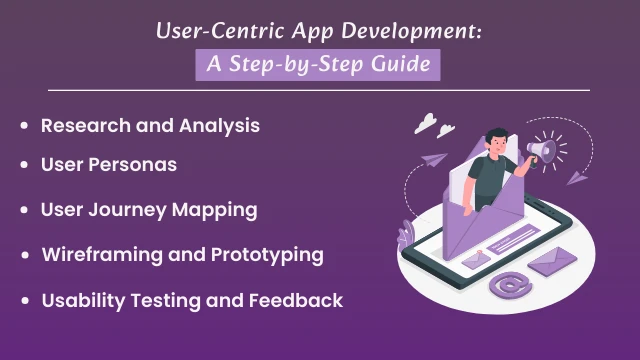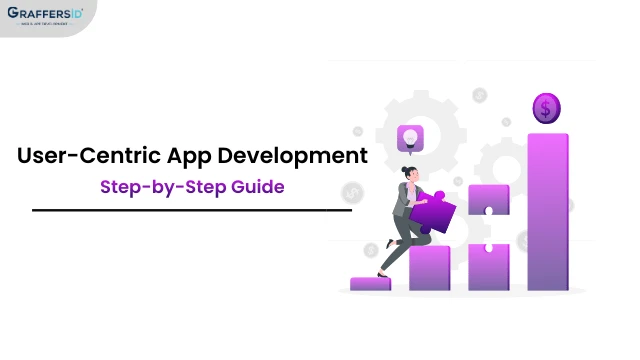Creating an app that truly resonates with users is no small feat. It requires a deep understanding of user needs, preferences, and behaviors. This guide will walk you through each step of the user-centric app development process, ensuring your app meets and exceeds user expectations.
What is User-Centric Design?
User-centric design revolves around the principle that the end-user is the focal point of the development process. This approach prioritizes user satisfaction by tailoring the app’s features, design, and functionality to meet the users’ needs.
Importance of User-Centric Design
Why should you care about user-centric design? Simply put, it leads to better user experiences, higher satisfaction, and ultimately, more successful products. By focusing on the user’s needs, businesses can create more intuitive, accessible, and enjoyable experiences. In fact, according to a study by Forrester, a well-designed user interface could increase conversion rates by up to 200%, and a better UX design could yield conversion rates up to 400%.
Principles of User-Centric Design
-
Understanding the User
The foundation of user-centric design is a deep understanding of the user. This involves researching user behavior, preferences, and pain points. It’s about knowing who your users are and what they need. For instance, 70% of online businesses fail because of bad usability.
-
Empathy and User Experience
Empathy is crucial in user-centric design. By putting yourself in the user’s shoes, you can design experiences that truly resonate with them. This means considering their emotions, motivations, and challenges throughout the design process. According to the Design Management Institute, companies that invest in UX research see a return on investment (ROI) of up to 9,900%.
-
Usability and Accessibility
A key principle of user-centric design is usability. This means creating products that are easy to use and navigate. Accessibility is equally important, ensuring that products are usable by people of all abilities and disabilities. The World Health Organization estimates that over 1 billion people live with some form of disability, highlighting the importance of accessible design.
-
Consistency and Standards
Maintaining consistency in design helps users feel comfortable and familiar with your product. Adhering to established design standards and conventions also enhances usability and reduces the learning curve for new users. Nielsen Norman Group reports that consistency is a top usability heuristic for user interface design.
User-Centric App Development: A Step-by-Step Guide

-
Research and Analysis:
The first step in implementing user-centric design is thorough research and analysis. This involves gathering data on user behavior, preferences, and pain points through surveys, interviews, and analytics. According to a McKinsey report, companies that leverage customer insights outperform their peers by 85% in sales growth.
-
User Personas:
Creating user personas helps in understanding different segments of your audience. Personas are fictional characters that represent the different user types that might use your product. They help in visualizing the user and tailoring the design to meet their needs. According to a study by MarketingSherpa, using personas makes websites 2-5 times more effective and easier to use by targeted users.
-
User Journey Mapping:
User journey mapping involves plotting out the steps a user takes to achieve a goal with your product. This helps in identifying pain points and opportunities for improvement at each stage of the user experience. 67% of users cite bad experiences as a reason for churn, emphasizing the importance of a smooth user journey.
-
Wireframing and Prototyping:
Wireframes are basic sketches of your product’s layout, focusing on functionality rather than design. Prototypes are more advanced models that simulate the final product. Both are essential for visualizing and testing your design before full-scale development. A study by Adobe found that companies that adopt prototyping save 50% of development time.
-
Usability Testing and Feedback:
Usability testing involves observing real users as they interact with your product. This helps in identifying any usability issues and gathering feedback for improvements. Iterative testing and feedback integration are crucial for refining the design. According to Usability.gov, every dollar invested in UX results in a return between $2 and $100.
Benefits of User-Centric Design
-
Improved User Satisfaction:
By focusing on the user’s needs, user-centric design leads to higher user satisfaction. Happy users are more likely to become loyal customers and advocates for your product. According to PwC, 32% of customers would stop doing business with a brand they loved after one bad experience.
-
Enhanced Product Usability:
Products designed with the user in mind are inherently more usable. This means fewer user errors, less frustration, and a more seamless experience. For instance, Toptal reported that simplifying the user interface reduced user errors by 75%.
-
Increased Conversion Rates:
A user-friendly design can significantly boost conversion rates. When users find it easy to navigate and use your product, they’re more likely to complete desired actions, whether it’s making a purchase or signing up for a service. The Design Management Institute found that companies that prioritize design see 56% higher stock market returns.
-
Reduced Development Costs:
Identifying and addressing usability issues early in the design process can save significant development costs down the line. It reduces the need for extensive redesigns and fixes after the product launch. IBM reported that every dollar invested in ease of use returns $10 to $100.
A user-centric approach prioritizes the needs, preferences, and behaviors of the end-users, ensuring that the app is intuitive, engaging, and useful. However, achieving this is no easy feat. Here are some of the common challenges developers face when striving to build user-centric applications, backed by real-life statistics to provide a more realistic perspective.
Common Challenges in User-Centric App Development
1. Understanding User Needs and Behaviors
Challenge:
Understanding what users want and need is the cornerstone of user-centric app development. However, this is often easier said than done. Users may have diverse needs, and predicting these accurately can be challenging.
Real-Life Stats:
- User Feedback Integration: According to a survey by PwC, only 38% of companies frequently incorporate user feedback into their product development process.
- User Behavior Analysis: A report by App Annie reveals that 65% of users abandon apps within the first month due to unmet expectations and poor user experience.
Solution:
Conduct comprehensive user research through surveys, interviews, and usability testing. Utilize analytics tools to track user behavior and gather actionable insights.
2. Balancing Features and Usability
Challenge:
Adding too many features can overwhelm users, while too few can render the app ineffective. Striking the right balance between functionality and simplicity is crucial.
Real-Life Stats:
- Feature Overload: The Nielsen Norman Group found that 42% of users find apps difficult to use due to feature overload.
- User Retention: A study by Localytics highlighted that apps that offer a streamlined user experience see a 25% increase in user retention over those with complex interfaces.
Solution:
Prioritize core features that align with user needs. Implement an iterative design process, where features are gradually introduced and tested for usability and relevance.
3. Ensuring Cross-Platform Compatibility
Challenge:
Users access apps on various devices with different operating systems, screen sizes, and resolutions. Ensuring a consistent and seamless experience across all platforms is challenging.
Real-Life Stats:
- Device Diversity: According to StatCounter, as of 2023, Android holds 71% of the global mobile OS market share, while iOS holds 28%. This indicates the necessity for cross-platform compatibility.
- Consistency Issues: A report by TechCrunch reveals that 57% of users are frustrated by inconsistencies between an app’s Android and iOS versions.
Solution:
Adopt responsive design principles and use cross-platform development frameworks like React Native or Flutter to maintain consistency across different devices and operating systems.
4. Managing Performance and Speed
Challenge:
Performance issues such as slow load times and crashes can significantly degrade the user experience, leading to high abandonment rates.
Real-Life Stats:
- Load Time Impact: Google’s research indicates that 53% of mobile users abandon sites that take longer than three seconds to load.
- Crash Rates: A study by Apteligent found that app crash rates average around 2%, with some apps experiencing rates as high as 5%.
Solution:
Optimize code for performance, minimize the use of heavy resources, and conduct rigorous testing under various conditions to ensure the app runs smoothly. Employ performance monitoring tools to identify and address issues promptly.
5. Navigating Privacy and Security Concerns
Challenge:
Users are increasingly concerned about their privacy and data security. Ensuring that the app adheres to data protection regulations and secures user data is essential.
Real-Life Stats:
- Privacy Concerns: According to a Pew Research Center survey, 81% of Americans feel that they have very little control over the data that companies collect about them.
- Security Breaches: A report by Symantec highlights that 43% of cyberattacks target small businesses, often through mobile apps.
Solution:
Implement robust security measures, such as encryption and secure authentication protocols. Ensure compliance with data protection regulations like GDPR and CCPA. Communicate privacy policies to users.
6. Maintaining Engagement and Retention
Challenge:
Keeping users engaged over time and preventing churn is a significant challenge. Apps often struggle to retain users beyond the initial download and onboarding phase.
Real-Life Stats:
- Retention Rates: According to CleverTap, the average 30-day retention rate for mobile apps is only 6%.
- User Engagement: A study by Localytics found that 25% of users abandon an app after just one use.
Solution:
Focus on providing continuous value through regular updates, personalized content, and engaging features. Utilize push notifications and in-app messages strategically to re-engage users without overwhelming them.
Case Studies of Successful User-Centric Design
-
Apple:
Apple is renowned for its user-centric design approach. By focusing on simplicity, ease of use, and aesthetic appeal, Apple has created products that are both functional and desirable. Their commitment to design has helped them achieve a market value of over $2 trillion.
-
Google:
Google’s emphasis on user-centric design is evident in its products like Google Search and Google Maps. By prioritizing speed, simplicity, and usability, Google has created tools that are indispensable to millions of users. Google reported a 20% increase in user satisfaction after redesigning their mobile search experience.
-
Airbnb:
Airbnb’s user-centric design approach has transformed the travel industry. By focusing on the needs of both hosts and guests, Airbnb has created a platform that is intuitive, trustworthy, and easy to use. Airbnb’s user-friendly design contributed to its $31 billion valuation as of 2020.
Future of User-Centric Design
-
Empathy-driven Experiences:
The future of user-centric design transcends mere functionality; it delves deep into the realm of empathy-driven experiences. Designers are not just crafting interfaces; they are crafting narratives that resonate with the users on an emotional level. By harnessing the power of empathy, future designs will foster deeper connections, understanding, and loyalty.
-
Personalization Redefined:
Gone are the days of one-size-fits-all solutions. The future of user-centric design lies in hyper-personalization, where every interaction is tailored to the individual user’s preferences, behaviors, and context. Through advanced AI algorithms and data analytics, future designs will anticipate user needs even before they are articulated, delivering seamless and intuitive experiences.
-
Multimodal Interfaces:
With the proliferation of voice assistants, gesture controls, and augmented reality, the future of user-centric design is inherently multimodal. Designers are tasked with creating cohesive experiences that seamlessly transition across different modes of interaction. From voice-enabled commands to immersive AR environments, future interfaces will cater to diverse user preferences and accessibility needs.
-
Ethical Design Principles:
As technology becomes increasingly intertwined with our daily lives, the ethical implications of design decisions come to the forefront. The future of user-centric design necessitates a commitment to ethical principles, ensuring transparency, inclusivity, and respect for user privacy. Designers must navigate the delicate balance between innovation and ethical considerations, prioritizing the well-being of users above all else.
-
Sustainability and Eco-conscious Design:
In an era of growing environmental awareness, sustainable design practices are imperative for the future of user-centric design. From eco-friendly materials to energy-efficient interfaces, designers are embracing sustainability as a core tenet of their craft. The future of user-centric design will prioritize solutions that minimize environmental impact while maximizing user value and satisfaction.
-
Collaborative Design Ecosystems:
No designer is an island; the future of user-centric design thrives within collaborative ecosystems where diverse perspectives converge. From co-creation with end-users to interdisciplinary collaboration with experts in psychology, sociology, and beyond, the design process becomes enriched and more holistic. The future belongs to designers who embrace collective intelligence and harness the power of collaboration to drive innovation.
-
Continuous Iteration and Adaptation:
In a rapidly evolving digital landscape, stagnation is not an option. The future of user-centric design is characterized by a mindset of continuous iteration and adaptation. Designers must embrace agility, learning from user feedback, data insights, and emerging trends to refine and evolve their designs iteratively. By staying nimble and responsive, future designs will remain relevant and impactful in an ever-changing world.
Build User-Centric App Development with GraffersID
Transform your ideas into impactful mobile and web applications with GraffersID. Our expert team specializes in creating user-focused solutions that drive engagement and growth. Partner with us to build intuitive, high-performing apps tailored to meet your business needs and exceed your users’ expectations. Join the ranks of successful brands that trust GraffersID to bring their vision to life. Let’s build something extraordinary together.
Conclusion
User-centric app development is an ongoing process that requires dedication and a keen understanding of your users. By following the steps outlined in this guide, you’ll be well on your way to creating an app that meets and exceeds user expectations.
Key Takeaways
- User-centric design is paramount for businesses aiming to succeed in today’s competitive landscape.
- By prioritizing user needs and preferences, companies can foster stronger connections and drive business growth.
- Successful case studies like Airbnb, Spotify, and Amazon exemplify the tangible benefits of user-centric design in action.
- Businesses must embrace a customer-centric mindset and continuously innovate to stay ahead of the curve.
FAQs
1. What is user-centric design?
User-centric design is a design philosophy that focuses on the needs, preferences, and limitations of the end user throughout the development process.
2. How does user-centric design benefit businesses?
It leads to higher user satisfaction, improved usability, increased conversion rates, and reduced development costs by addressing usability issues early on.
3. What tools are essential for user-centric design?
Essential tools include user research tools (like Google Analytics), design and prototyping tools (such as Sketch and Figma), and usability testing tools (like UserTesting).
4. What are the main challenges in implementing user-centric design?
Challenges include balancing business goals with user needs, catering to diverse user requirements, and continuously iterating based on user feedback.
5. How can I start incorporating user-centric design in my projects?
Start with thorough user research, create user personas, map user journeys, develop wireframes and prototypes, and conduct usability testing to gather feedback and make improvements.



